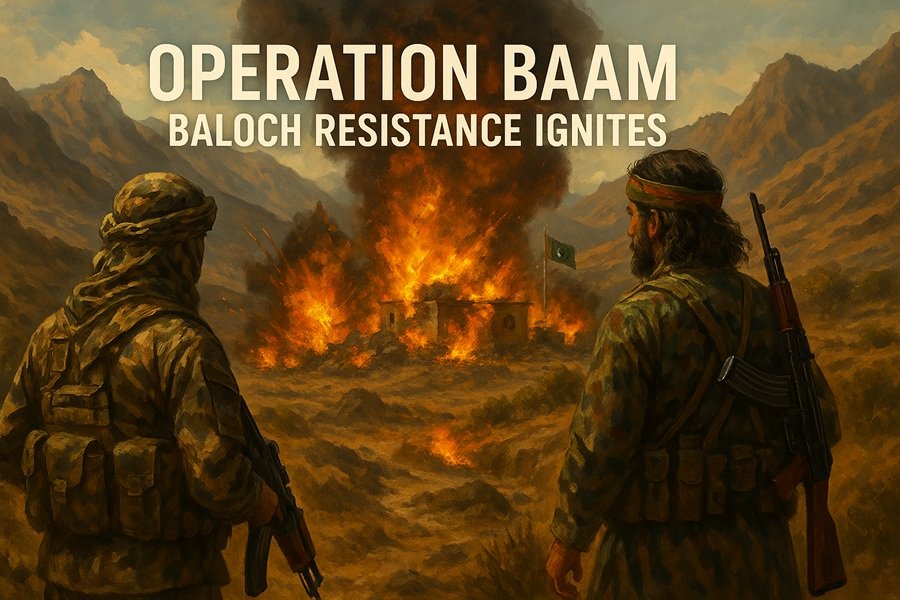
Date: July 11, 2025
Location: Balochistan, Pakistan
What Is Operation BAAM?
Operation BAAM is a newly launched offensive by the Baloch Liberation Front (BLF)—a separatist militant group operating in Balochistan. This operation marks one of the most extensive and coordinated insurgent attacks on Pakistani military and government installations in recent years. The name “BAAM” stands for “Baloch Armed Action Movement”, symbolizing a renewed strategy by the BLF to escalate its fight for Baloch sovereignty.
Scale of the Attack: 17 Targets Struck Simultaneously
On July 10, 2025, BLF operatives executed a synchronized assault on 17 separate sites across the restive Balochistan province. The targeted locations included:
- Panjgur
- Surab
- Kech (Turbat region)
- Kharan
- Awaran
- Gwadar and surrounding coastal regions
- Mountainous interior zones
These areas are known strongholds of the Pakistani military and paramilitary Frontier Corps (FC), which has been accused of human rights violations and violent suppression of Baloch nationalist movements.
Tactical Objectives of the Operation
According to a statement released by BLF spokesperson Major Gwahram Baloch, the operation aimed to:
- Demonstrate strategic reach across Balochistan.
- Paralyze military infrastructure through sabotage.
- Disrupt state communication lines.
- Strike fear and confusion in Pakistani military ranks.
- Deliver a symbolic blow to Islamabad’s claims of stability in the province.
The coordinated nature of the attack shows significant logistical planning, local support, and intelligence capabilities within the BLF.
📍 Key Installations Targeted
While the BLF has not disclosed all the operational details, sources suggest the following targets:
- Military checkpoints and outposts
- Telecommunication towers
- Security convoys
- Radar and surveillance units in coastal belts
- Strategic road links used for troop and supply movements
Some communications blackouts have been reported in Kech and Panjgur, indicating likely damage to cellular and fiber optic networks.
Claimed Impact: Heavy Pakistani Casualties
While official Pakistani sources have not confirmed exact casualty figures, BLF sources claim:
- Dozens of Pakistani soldiers were killed or injured.
- Multiple vehicles, arms depots, and checkpoints were destroyed.
- The Pakistan Army was caught off-guard in many locations due to the sudden and coordinated nature of the attack.
Reports from local sources in Balochistan also hint at intensified aerial surveillance and troop movement post-operation, indicating panic and a potential counter-insurgency build-up.
BLF’s Statement: “A New Phase of National Liberation”
In the post-operation statement, Major Gwahram Baloch declared:
“Operation BAAM is the beginning of a new chapter in the Baloch national struggle. We have proven that we can coordinate and strike across the length and breadth of our occupied homeland. This is not the end—it is only the beginning.”
The language suggests a long-term escalation plan and a symbolic shift from sporadic guerilla attacks to strategic warfare.
Strategic Implications for Pakistan
1. Security Breakdown in Balochistan
This operation reveals serious gaps in Pakistan’s internal intelligence and security preparedness. Despite decades of military presence, the Pakistani Army continues to struggle to maintain control in Balochistan.
2. Growing Strength of the Baloch Resistance
Operation BAAM shows that BLF and allied insurgent groups have:
- Expanded their operational zones.
- Gained access to advanced tactical planning tools.
- Secured logistical and possibly cross-border support.
3. Crisis for Pakistan’s Global Image
The timing of the attack—amid diplomatic efforts to showcase Pakistan as an investment destination—will likely embarrass Islamabad on the international stage. It raises doubts about:
- The safety of CPEC projects
- China’s investments in Gwadar Port
- The internal stability of Pakistan as a state
International Reactions (So Far)
While there is no official international reaction yet, regional observers are:
- Watching India’s diplomatic posture closely—especially after recent tensions along LoC and Arunachal Pradesh.
- Noting how China may react, given its multi-billion-dollar investments in Balochistan under CPEC.
- Tracking Iranian border activities, as parts of southern Balochistan border Iranian Baloch regions.
Pakistan’s Response and Denial
Pakistani officials have neither confirmed nor denied the extent of the damages. Historically, the Pakistan Army tends to:
- Downplay losses in Balochistan.
- Censor national media coverage.
- Intensify counter-insurgency operations including airstrikes, arrests, and blockades.
It remains to be seen whether Islamabad will:
- Acknowledge the scale of Operation BAAM.
- Open new rounds of dialogue.
- Or escalate its military response, risking further civilian casualties and backlash.
Historical Context: Balochistan’s Long Fight
Balochistan has been a hotbed of separatist resistance since Pakistan’s formation in 1947. The Baloch people have long complained about:
- Lack of political autonomy
- Exploitation of natural resources (gas, gold, copper)
- Cultural and linguistic suppression
- Disappearances and extrajudicial killings
BLF is one of several groups—alongside BLA and BRA—demanding an independent Balochistan.
Conclusion: A Turning Point?
Operation BAAM marks a serious escalation in the Baloch conflict. It signals that:
- The Baloch insurgency is far from over.
- Pakistan’s control over Balochistan is increasingly fragile.
- The conflict is likely to become more internationalized, especially if it affects Chinese interests or border tensions.
This is not just a security issue for Pakistan. It is a political and moral crisis—one that Islamabad can no longer afford to ignore.





